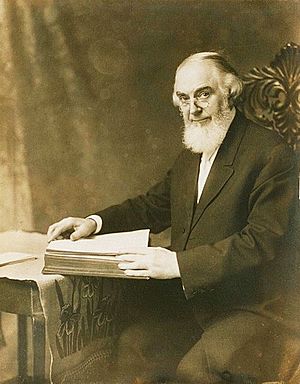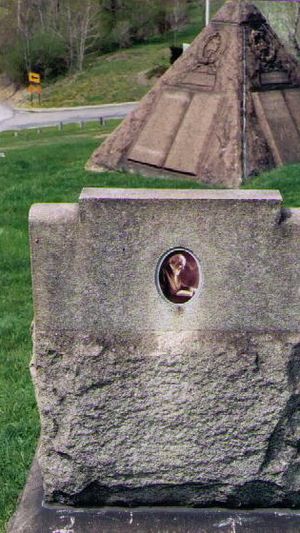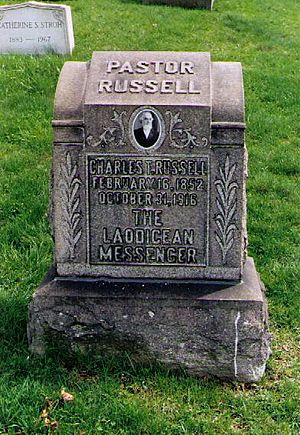Charles Taze Russell facts for kids
Quick facts for kids
Charles Taze Russell
|
|
|---|---|

Russell in 1911.
|
|
| Born | February 16, 1852 Allegheny, Pennsylvania, U.S.
|
| Died | October 31, 1916 (aged 64) Pampa, Texas, U.S.
|
| Occupation | Writer, pastor |
| Signature | |
Charles Taze Russell (born February 16, 1852 – died October 31, 1916), also known as Pastor Russell, was an American Christian minister from Pittsburgh, Pennsylvania. He is known for starting a religious movement called the Bible Student movement. After he died, two main groups grew from this movement: Jehovah's Witnesses and several independent Bible Student groups.
In July 1879, Russell started publishing a religious magazine called Zion's Watch Tower and Herald of Christ's Presence. In 1881, he helped create the Zion's Watch Tower Tract Society. He became its president in 1884. Russell wrote many articles, books, and sermons. From 1886 to 1904, he published a six-book series for Bible study called Studies in the Scriptures. Nearly 20 million copies of these books were printed and shared worldwide during his lifetime.
After Russell's death, there was a disagreement about who should lead the Watch Tower Society. Many Bible Students left the group. Those who stayed with the Watch Tower Society later became known as Jehovah's Witnesses in 1931. Other groups formed their own organizations, like the Pastoral Bible Institute and the Dawn Bible Students Association.
Contents
Early life and spiritual journey
Charles Taze Russell was born on February 16, 1852, in Allegheny, Pennsylvania. His parents were from Scotland and Ireland. He was the second of five children, but only two lived to be adults. His mother died when he was nine years old.
His family lived in Philadelphia for a while before moving to Pittsburgh. There, they joined the Presbyterian Church. When Charles was a teenager, his father made him a partner in his clothing store. By age twelve, Charles was already writing business agreements for customers. He even managed some of his father's other stores. At thirteen, he left the Presbyterian Church to join the Congregational Church. As a young person, he would write Bible verses on fences and sidewalks. He wanted to encourage people to believe in God.
At age sixteen, Charles had a talk with a friend about things they saw as wrong in Christianity. This made him question his faith. He looked into other religions but did not find the answers he wanted. In 1870, when he was eighteen, he went to a talk by a minister named Jonas Wendell. Russell later said that this talk made him feel excited again about the Bible. He became convinced that the Bible was truly God's word.
Marriage and family life
On March 13, 1879, Charles Russell married Maria Frances Ackley. They had known each other for a few months. The couple separated in 1897. Maria Russell later sought a legal separation, which was granted in 1908. Maria Russell passed away in 1938 at the age of 88.
Ministry and publications
Russell was a very engaging speaker. He said that he did not receive special messages from God. He also said he did not want to start a new religion. Instead, he wanted to bring together people who were looking for the truth from God's Word. He believed that the clear understanding of truth in his teachings was because "God's due time has come." He saw himself and other Christians as "God's mouthpiece."
Starting his work
Around 1870, Russell and his father started a group to study the Bible. They looked at Christian beliefs and traditions. This group was influenced by ministers George Storrs and George Stetson. They concluded that many church teachings, like the Trinity, hellfire, and the idea that the soul lives forever, were not clearly taught in the Bible.
In 1876, Russell received a magazine from an Adventist writer named Nelson Barbour. Russell invited Barbour to meet him. Russell paid for Barbour and another minister to visit him in Pennsylvania. Russell was eager to lead a Christian revival. He sold his five clothing stores for about $300,000 to support his work.
Disagreement with Barbour
Barbour and Russell had believed that Christians would be taken to heaven in April 1878. When this did not happen, it was a big disappointment. However, one of Russell's friends said that Russell was not upset.
While talking with Russell about the events of 1878, I told him that Pittsburgh papers had reported he was on the Sixth Street bridge dressed in a white robe on the night of the Memorial of Christ's death, expecting to be taken to heaven together with many others. I asked him, "Is that correct?" Russell laughed heartily and said: "I was in bed that night between 10:30 and 11:00 P.M. However, some of the more radical ones might have been there, but I was not. Neither did I expect to be taken to heaven at that time, for I felt there was much work to be done preaching the Kingdom message to the peoples of the earth before the church would be taken away.
—Alexander Hugh Macmillan
Russell re-examined his beliefs to see if they came from the Bible or from human traditions. He concluded that some ideas were traditions. He wrote about his findings in Barbour's magazine. Barbour disagreed with Russell's explanations. They debated their views in the magazine. They also disagreed about the meaning of Christ's ransom sacrifice. Because of these disagreements, they eventually went their separate ways.
Russell stopped giving financial support to Barbour's magazine. In July 1879, he started his own journal, Zion's Watch Tower and Herald of Christ's Presence.
Watch Tower Society
In 1881, Russell founded the Zion's Watch Tower Tract Society. William Henry Conley was the first president, and Russell was the secretary-treasurer. Their goal was to spread religious writings and Bibles. Russell's own company printed the materials. Then, people called colporteurs distributed them. The Society became an official organization in 1884, with Russell as president. In 1886, its name changed to Watch Tower Bible and Tract Society.
In 1908, Russell moved the Society's main office to Brooklyn, New York. It stayed there until 2016.
Important publications
After forming the Watch Tower Society, Russell worked even harder in his ministry. His Bible study group grew to hundreds of members. They were in many parts of the United States and other countries. They voted for him each year to be their "Pastor."
In 1881, Russell published his first widely distributed work, Food for Thinking Christians. This 162-page booklet was printed using about $40,000 in donated money. Nearly 1.5 million copies were shared in the United States, Canada, and Great Britain in just four months. That same year, he published Tabernacle and its Teachings. This book explained his understanding of the animal sacrifices and tabernacle ceremonies from the Bible.
By 1903, newspapers began printing his sermons. These sermons were shared in up to 4,000 newspapers worldwide. They reached an estimated 15 million readers in the United States and Canada.
In 1910, a magazine called Overland Monthly said that Russell's writings were the most widely distributed privately produced English books in the United States. It also said his works were the third most circulated on Earth, after the Bible and the Chinese Almanac.
Studies in the Scriptures
Russell spent a lot of his own money, plus donations, to publish his works. In 1886, he began publishing a series of seven books. They were first called Millennial Dawn, but later renamed Studies in the Scriptures. Russell published six volumes:
- The Divine Plan of the Ages (1886)
- The Time is at Hand (1889)
- Thy Kingdom Come (1891)
- The Battle of Armageddon (1897)
- The At-one-ment Between God and Men (1899)
- The New Creation (1904)
Bible Students eagerly awaited the seventh book. After Russell died in 1916, a seventh volume called The Finished Mystery was published in 1917. It was advertised as his "posthumous work," meaning published after his death. This book explained parts of the Bible like the Book of Revelation. It was later found that much of it was written by two of Russell's helpers and edited by Joseph Franklin Rutherford, the new president of the Watch Tower Society.
Photo Drama of Creation
Russell also created a special presentation called The Photo-Drama of Creation. This was an eight-hour religious film shown in four parts. It was very new for its time because it combined synchronized sound, moving film, and color slides. The project started in 1912 and was shown in 1914. It cost about $300,000 to make.
Beliefs and teachings
After studying the Bible, Russell and other Bible Students believed that some Christian traditions were mistakes. They thought their work was to bring Christianity back to how it was in the first century. Many church leaders at the time called his ideas "heresy." Russell agreed with other Protestants that the Bible was most important. He also believed that errors had been added to how the Bible was understood.
His Bible interpretations were different from those of many other Christians in these ways:
- Hell. He taught that there would be a heavenly resurrection for 144,000 righteous people. He also believed a "great multitude" would go to heaven. But he thought that most other people would "sleep" in death, waiting for an earthly resurrection. They would not suffer in a literal burning hell.
- The Trinity. Russell believed Jesus was divine. However, he taught that Jesus received this divinity as a gift from God after dying on the cross. He also taught that the Holy Spirit was not a person, but God's power in action.
- Christ's Return. Russell believed that Christ had returned invisibly in October 1874. He thought Christ had been ruling from heaven since that time. He believed a "time of trouble" began then. This would lead to the end of the "Gentile Times" in October 1914. After World War I began, Russell saw 1914 as the start of Armageddon.
- Pyramidology. Russell believed that the Great Pyramid of Giza was built under God's direction. He called it "the Bible in stone." He thought certain Bible verses predicted that people would understand the Great Pyramid in modern times. He believed its passages showed things like the fall of humans, the giving of God's Law, and Christ's death. He used measurements from the pyramid to calculate dates like 1874, 1914, and 1918.
- Christian Zionism. Russell taught that God's favor had returned to the Jews in 1878. He believed that the land of Palestine belonged only to the Jewish people. He thought God was calling them back to their land. He believed they would be the center of earthly leadership under God's Kingdom. He even thought Jews might form their own nation in Palestine by 1910. Before he died, he stressed that 1914 meant Gentile nations no longer had earthly authority. He said that from then on, Jews were allowed and guided by God to gather in Palestine and reclaim their land.
- Spiritualism and the occult. Russell strongly spoke out against Spiritualism.
Death and legacy


Russell's health had been getting worse for three years before he died. During his last trip to the western United States, he became very ill. He died on October 31, 1916, at age 64, near Pampa, Texas. He was on a train returning to Brooklyn. A friend said that at 64, Russell's body was more worn out than his father's, who died at 84. He was buried in United Cemetery in Pittsburgh. His grave has a headstone. Nearby, there is a 7-foot-tall pyramid memorial. The Watch Tower Bible and Tract Society put it there in 1921.
In January 1917, Joseph Franklin Rutherford was chosen as the new president of the Watch Tower Bible and Tract Society. There were disagreements about how he was elected. There were also arguments about how to interpret Russell's will and who could print new religious books. By the late 1920s, many Bible Student groups disagreed with Rutherford's changes. They left the Society.
Those who stayed with Rutherford adopted the new name "Jehovah's witnesses" in 1931. They renamed their magazine The Watchtower. Many of the Bible Students who left the Society held their own meetings. They tried to gather other people who disagreed with the changes.
See also
| Part of a series onBible Students | |
| General information | |
|---|---|
| Bible Students | |
| Bible Student movement | |
| Communities | |
| Associated Bible Students Free Bible Students Laymen's Home Missionary Movement IBSA · Jehovah's Witnesses |
|
| Publishing houses | |
| Christian Millennial Fellowship | |
| Dawn Bible Students Association | |
| Pastoral Bible Institute | |
| Watch Tower· IBSA | |
| Publications | |
| The Dawn · The Herald The New Creation Frank and Ernest (broadcast) Studies in the Scriptures The Photo-Drama of Creation The Watchtower· Awake! |
|
| Biographies | |
| Charles Taze Russell Jonas Wendell · William Henry Conley Nelson H. Barbour · Paul S. L. Johnson A. H. Macmillan · J. F. Rutherford |
|
| Beliefs | |
| Jehovah · Nontrinitarianism · Ransom Dispensationalism · Sheol and Hades Resurrection · Annihilationism |
|
| Part of a series on Jehovah's Witnesses |
|---|
| Demographics |
| Jehovah's Witnesses by country |
| Organizational structure |
| Governing Body Faithful and Discreet Slave Watch Tower Bible and Tract Society Corporations of Jehovah's Witnesses |
| History |
| Bible Student movement Jehovah's Witnesses splinter groups |
| Beliefs & Practices |
| Doctrines |
| God's name · Eschatology · Blood · Disfellowshipping |
| Literature |
| The Watchtower · Awake! New World Translation |
| Controversies |
| Related people |
| Watch Tower Presidents |
| W.H. Conley · C.T. Russell · J.F. Rutherford · N.H. Knorr · F.W. Franz M.G. Henschel · D.A. Adams |
| Formative influences |
| William Miller · N.H. Barbour · George Storrs |
| Notable Former Jehovah's Witnesses |
| Raymond Franz · Olin Moyle |
 In Spanish: Charles Taze Russell para niños
In Spanish: Charles Taze Russell para niños
Images for kids



